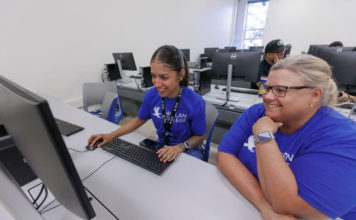Erato, the muse of poetry, is alive in South County
April may be the cruelest month to T.S. Eliot but, for poetry lovers, it is the best time of the year. Ever since April was designated “National Poetry Month,” poems and poets have popped up everywhere – as if they were May flowers.
Most adults studied poetry in school with little enthusiasm but some special, lucky people do. They are hard at work, reading, writing, sharing verse with friends – finding that poetry enhances their lives. Where would an adventurous, but normally poetry-adverse, person go in South County to see what the fuss is about? Is anybody teaching the next generation about the joys of poetry?
Library programs
Libraries, of course, are crammed with books of poetry. During April poems tend to break out and array themselves on walls and tables. This year at the Gilroy Library the staff produced a display of little pockets with poems tumbling out called “Keep a Poem in Your Pocket.” The Gilroy Library has a well-developed poetry program for children.
Linda Glawatz, the children’s librarian, said their program engages kids first through eighth grades. During monthly poetry hours children are encouraged to bring their favorite poems to read or act out. Gently teaching, Glawatz introduces different styles – haiku, limericks and concrete poetry to name a few.
A concrete poem is a shaped poem. Douglas Florio and J. Hollander use this method to heighten the tactile image of words. A poem about a circle has the words marching around in a circle; one about a worm practically wiggles on the page.
Librarians talk about ballads and beginnings – most children heard Mother Goose first. Hand or glove puppets lower inhibitions about performing in public. The puppet acts out the poem and the child can just be along for the ride.
The “class” starts with lullabies – “Hush, little baby, don’t say a word” – and moves on to picture books. A favorite is “Stopping by Woods on a Snowy Evening” by Robert Frost – illustrated for children.
Whose woods are these I think I know
His house is in the village though;
He will not see me stopping here
To watch his woods fill up with snow …
“The Owl and the Pussycat” is usually a big hit too. Children have a highly developed sense of silly.
Glawatz says it is important that children see how text in picture books can rhyme. Her audiotape of “Chicka Chicka, Boom, Boom” illustrates this in a delightful way.
Glawatz’s favorite poems are “A Tale of Custard the Dragon” by Ogden Nash, “Forgiven” by A.A. Milne (Winnie the Pooh) and “Happiness” by Binker. Jack Prelutsky (“It’s Raining Pigs and Noodles”) and Shel Silverstein (“Where the Sidewalk Ends,” among others) are known and loved now by several generations of kids. Who could grow up without knowing Silverstein’s poem “Sick” by heart?
The Gilroy Library’s poetry program brings children in to write their own poems. Each child receives a blank book for writing or keeping a journal, bookmarks, poetry cards and a flyer for the next program. Coming up: Wednesday, May 22, 3:30 p.m. Poetry hour ceases during the summer because kids are busy with the Summer Reading Program but it starts up again in September.
The Morgan Hill Library, alas, has had little luck with poetry programs for kids.
“We tried an open mic night for teens two or three years ago,” said Librarian Bev Vessa, “but nobody showed up.”
A magnetic poetry setup near the reference area is popular but formal programming was not. And, except for reading to children during the normal Story Hours, there have not been any other poetry programs for children in the recent past.
Poets’ group
The seven-year old Garlicky Group of Poets meets monthly, now at the Gilroy Library though, funnily enough, most of its members live in Morgan Hill. Wherever they are from, these adults share their own works in progress or works completed. They share old favorites, a just discovered poet or, in the case of Garlicky Group founder, Ed Nauss, an effort by his sister.
On a recent Saturday the dramatic Carroll Briggs read his own: “Take words out for a walk … ” to the amusement and appreciation of his fellows. Carol Gardner writes her own greeting card rhymes since she is not always happy with what is on the shelf.
T.S. Eliot’s “The Wasteland” – “April is the cruelest month … ” intrigued Bob Everett. Bob was not only interested in the poem but its derivation. He said a kind librarian helped him discover the origin at the end of Steinbeck’s “Cannery Row.”
Cat appreciators will want to check out “Poems by the Cats of Major Poets”, a highly entertaining set of parodies. Joyce Kilmer’s (Trees – “I think that I shall never see a poem as lovely as a tree”) cat has apparently written “Treed.” You can imagine what it’s about. The afternoon favorite was “Do not go peaceable to that damned vet” by Dylan Thomas’ cat. Thomas, of course wrote “Do not go gentle into that good night …” Delores Parker brought this little gem to share with her 10 poetic friends. Garlicky Poets meet the second Saturday of the month but call the Gilroy Library to be sure.
Poetry on the airwaves
Poetry is not entirely missing from the airwaves. KUSP, 88.9 FM in Santa Cruz has a poetry show broadcast each Sunday from 8 to 9 p.m. The station can be heard from many sites around the South County. If it doesn’t come in on 88.9, try other nearby frequencies.
Possibly stoking up the interest in poetry is the popularity of Robert Haas (a Bay Area boy) and Robert Pinsky, both recent National Poets Laureate. Whoever is the current Laureate appears occasionally on “The Evening News” with Jim Lehrer, 6 p.m. weeknights, KQED Channel 9 from San Francisco. Giving weight to the value of poetry, the program sometimes asks random folks from around the nation to read a favorite poem on the air.
Open Mic nights
Though a facinating idea, open mic nights appear to be diminishing in favor in many places. However, the Wild Rose House of Taste (7400 Monterey, 842-2242) and Garlic City Coffee (7501 Monterey, 842-4220), both in Gilroy, and Faultline Coffee in Hollister, all offer them. The Wild Rose is planning a special women’s open mic night but no dates are set yet. The Fat Cat Café and Brew Pub in Morgan Hill (Monterey and W. Dunne near Togo’s) sometimes opens its mic too. At Garlic City, poets are encouraged to read original works and/or play original guitar compositions. The only rule is that everyone’s contributions must be respected.
Poets seeking some anonymity should keep an eye out for open mic nights in San Jose – nobody knows you and you can get some experience before an audience.
Poetry in school
Occasionally the younger generation forges ahead of its elders.
Catie Pavoni of Hollister, 13, writes “dark poetry” that express her feelings as a teenager, according to her mother Tracie.
“Catie often feels a little outcast since she is past the girlfriend/boyfriend, giggly stuff,” Tracie said. “She has an adult outlook on things. She comes from a different place than most kids.” However, when kids read her work they identify with it.
The Columbine incident (in Colorado) has a lot to do with her poetry, Tracie said.
“It scared her; poetry is a really good outlet.”
Catie’s English teacher at Margaret Mays Middle School in Hollister prods her along, Tracie said.
“She has been writing for years (since she was 11 or 12),” said Lehanna Boyd, a friend of Catie’s mom. “Poetry is therapeutic for her.”
Catie is the youngest of four children, if you count her very slightly older twin brother. She wants to join the military. She wants to be a writer, to sing, to fly helicopters. Or all four.
Untitled
Shadows slip stealthily across the night
They give me a deathly chill
The hairs on the back of my neck stand up
The sun’s gone beneath the hill …
– from a poem by Catie Pavoni
Glass Eyes
What do you see when you look in my eyes?
Chips of icy baby blue?
Could you loose yourself inside?
Or can you see right through? …
– from a poem by Catie Pavoni
Verse has not yet been entirely abandoned at local schools either.
Ken Repp, Live Oak High School English teacher and department head said all English classes have poetry units.
“We have a creative writing class on the books but there haven’t been enough students signing up to run the class,” he said. The school literary magazine, Beaux Arts, ceased a year ago after the retirement of Joan Mazur, its major impetus and fan.
“It probably needs to be resuscitated,” Repp said. Still, some classes have their own literary magazines, he said.
Gavilan Community College tries to nurture poets. A class called “Poetry for Breakfast” was planned for March. Its teacher, Tahiya Marome, said hardly anyone signed up so the class was canceled. She said colleagues at other colleges agree that people just are not taking “for-fun classes” right now. Open mic nights are “drying up” everywhere.
“Sometimes you let go of the things you should be keeping in times of trouble,” she said.
Marome said she finds poetry calming. Some of her poems rhyme; others do not. She writes “typical introspective stuff.”
“Poetry,” she said, “has a lot to offer.” Marome is surprised with how well-versed in the poetry of their own countries her foreign students are. She likes teaching and may give “Poetry for Breakfast” another chance. Poetry enthusiasts, she suggests, should check the web for opportunities. Search writers’ guilds and groups that may have open mic nights. The site www.poetry.com allows poets to post their own work on the Internet.
Marci Douglas teaches creative writing at Gavilan on several levels. English 9C is the class on poetry writing that, she said, always has good enrollment. When the new television studio is installed at Gavilan the class will be available over cable.
Douglas’ Introduction to Poetry class is based on 13 American poets, “Voices and Visions.” In English 1B students tend to like Robert Frost the best, she said.
“So do I,” Douglas said. They also favor “Richard Corey” by Edward Arlington Robinson. Occasionally “The Lovesong of J. Alfred Prufrock” by T.S. Eliot gets the nod.
Let us go then, you and I,
When the evening is spread out against the sky
Like a patient etherized upon a table;
Let us go, through certain half-deserted streets, …
Every year in April, Douglas says, southern Santa Clara, Monterey and Santa Cruz County colleges and universities engage in a poetry contest run through Hartnell Community College in Salinas. They choose their best poems and send them off to be judged.
Louise Loots, another Gavilan English teacher, encourages her students to write poetry.
“If I say ‘write a poem’ often (my students) are quite natural poets. They will write free verse, not rhymed. It’s quite wonderful. Or, I could say, ‘here’s the beginning of a poem, now finish it. That is better than saying ‘OK, write a poem for creative writing class.'” Loots says her students especially love “Green Eggs and Ham” by Dr. Seuss.
She has, in the past, been in charge of the literary magazine and plans to encourage one next year. The magazine accepts poems, stories and art work from everyone at Gavilan and the community at large. Watch for the ads.
Poetry festival
Loots is enthusiastic about the upcoming Poetry Festival planned for Saturday, May 11, 9:30 a.m. – 5 p.m. Nationally known poet Sara Miles will share her work with listeners. “Poets” can choose from 16 to 18 workshops on generating new poetry, revising, performing, techniques and getting published. Profits will provide seed money for the literary magazine. Poets and poetry lovers of all ages are welcome.














